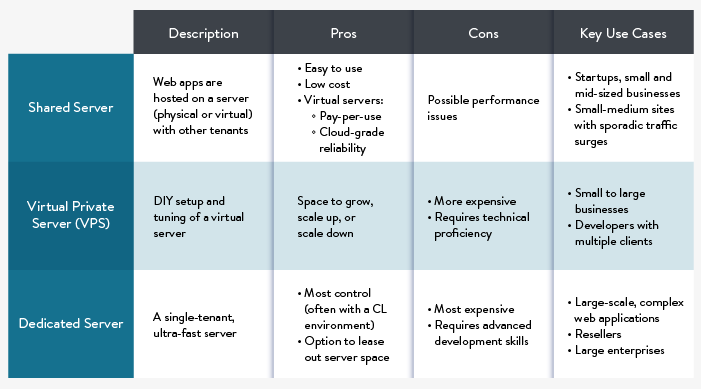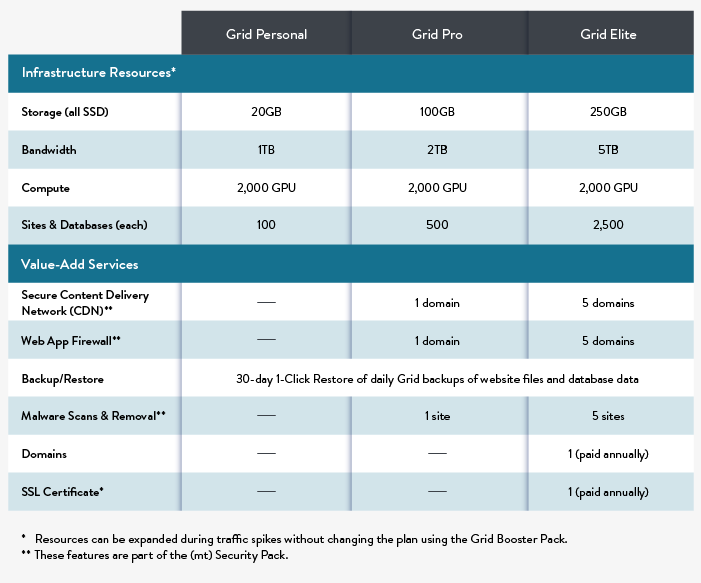Skip the Learning Curve with Managed Hosting
There is a wide spectrum of ways to host web applications, ranging from fully self-owned and self-controlled infrastructures to fully managed hosting services. Within that range, there are many “flavors” of managed hosting, including — just to make life more interesting — self-managed. Happily, the various web hosting options are not mutually exclusive and can be easily mixed and matched within one organization. There is no one-size-fits-all answer, and each company must choose the most appropriate solutions for their web assets and teams.
In this white paper, we explore the trade-offs and benefits of different web hosting strategies and solutions and provide guidelines for making informed policies and decisions.
Managed Versus DIY Infrastructure
If you think of web hosting management as a decision tree, the first fork is deciding between managed and DIY (do-it-yourself) hosting. DIY, in this context, means taking full ownership of the hardware and operating systems; the facility that houses them (including physical and cyber security, power, cooling, and so on); connectivity to external networks, as well as the lateral networks within the organization; and all software related to securing, monitoring, and managing the infrastructure.
For the most part, DIY is not a viable option for small to mid-sized organizations. Even in colocation scenarios that eliminate the burdens of managing the facility and external connectivity, DIY hosting diverts too many resources that should be focused on the core business.
DIY is a costly and resource-consuming undertaking for larger organizations as well. The costs of fully managed in-house hosting include:
- The initial capital investment in web hosting IT equipment (servers, routers, switches, firewalls, load balancers, storage appliances, and more), as well as technology refreshes every five years or so.
- Setting up and securing a facility. This can range from tens of thousands of dollars to several million dollars, depending on the size of the facility.
- Software licenses, as well as installation and maintenance costs. These can run from $3,000 to $30,000 per year, depending on the scope of the organization’s hosting needs.
- Connectivity costs. Based on data transfer and bandwidth needs, external connectivity costs range from $500 to $5,000 per month.
- At least one employee to manage everything, at a typical FTE (full time equivalent) cost of $110,000 a year.
From a total cost of ownership (TCO) perspective, the financial analysis firm, Alinean, found that for every $1 an organization spends on DIY infrastructure capital expenditures (hardware, software, storage, and networking appliances), it spends $2 on managing and securing that infrastructure—from operational costs to indirect business costs, such as planned and unplanned downtime.
There may indeed be some web applications for which DIY or colocation hosting is the right answer—for example, compliance requirements or legacy applications that cannot be migrated without a high level of operational risk. For the most part, however, the benefits of managed infrastructure are compelling, including:
- The shift from sunk CAPEX investments to more agile OPEX budget lines.
- Lowered costs due to the sheer economies of scale involved with managed hosting.
- Predictable monthly billing.
- Flexibility and scalability for optimized and cost-effective right sizing of resources in dynamic business environments.
- Access to multiple geographic locations, which supports important business KPIs such as high availability, compliance, and seamless business continuity in the face of failures or disasters.
Shared, Virtual Private, or Dedicated Servers
If you have decided to take the plunge into managed hosting, you need to understand the three main kinds of infrastructure hosts/servers: shared, virtual private, and dedicated. They are summarized in the table below.
Media Temple’s hosting products and services cover the full gamut of server types. For example, our Grid packages are based on shared servers with different levels of storage, bandwidth, and compute capacities that support varying numbers of sites and databases. All Grid packages include backup/restore and email services as well as a Managed Apps installer for leading applications such as WordPress, Drupal, and Zen Cart. The more advanced packages, Grid Pro and Grid Elite, also provide malware protection, domain management, and an SSL certificate. A Booster Pack is available to temporarily add hosting resources during significant traffic spikes.
Our Managed WordPress service is a good example of a shared hosting that is optimized for the needs of a specific application. Tuned for fast and remarkable WordPress end-user experiences, Managed WordPress automatically installs WordPress system and security updates and provides unlimited bandwidth, SSD storage, SFTP access, automatic malware scanning, and daily snapshot backups.
DV Managed offers professional-grade managed VPS hosting on high-end hardware, allowing the user to choose between a Plesk or cPanel control panel with their many automated features. DV Developer is also a VPS hosting. Other than Linux daemons and SSH, however, all of its system services and software are self-installed and self-managed.
Last but not least, Dedicated Server offers the full feature sets of the DV Managed and DV Developer hosting packages, but on a larger-scale, single-tenant, dedicated server.
Self-Managed Hosting
Although it might sound like an oxymoron, self-managed hosting is a type of managed hosting. Self-managed hosting is the most basic level of outsourced hosting, where the customer gains access to a bare-metal server with an installed operating system. Whether that server is VPS or dedicated, the customer is now responsible for all other installations, configurations, and management—including installing system-level software, such as Apache.
Self-managed hosting is best for development and operations teams with high levels of technical expertise who are running complex and diverse web applications and campaigns. These teams need complete control over their development and production environments, but they are happy to let outside experts deal with compute storage scaling, load balancing, and security issues.
A good example of a self-managed VPS hosting is Media Temple’s DV Developer package, described above. With their choice of bare-bones Linux server operating systems (Ubuntu, Debian, Fedora, or CentOS) and root access via an SSH Shell, the customer then installs, customizes, and configures their own LAMP stack and other required software. DV Developer supports unlimited domains and email addresses and provides between 20GB and 500GB of storage, depending on the service tier. The customer can also scale seamlessly and dynamically between service tiers in order to meet unpredictable and volatile traffic demands in a cost-effective manner. The DV Developer package also supports container-level system management via the Parallels Power Panel.
As noted above, the Dedicated Server package also offers self-managed hosting, but in a fully dedicated hosting environment. In order to allow similar services to migrate freely between the Dedicated Server package and Media Temple’s DV series of VPS hosting packages (including DV Developer), Dedicated Server runs on VPS technology. However, the size of the virtualized container is the size of the entire server.
Managed Hosting
Managed hosting is not just about outsourcing the management of the infrastructure. Managed hosting packages typically offer a wide range of value-added services that can either be integral to the package subscription or provisioned on an on-demand basis. The most notable hosted services include:
- Automated backups which are stored separately from the application’s production server. These backups should also include databases.
- Application and network performance monitoring and logging with alerts when customer-defined performance thresholds are breached.
- Security and intrusion-protection controls, such as web application firewalls, malware scanning, and even automated malware removal.
- A control panel or API integration with industry-leading control panels (such as Plesk or cPanel) for creating databases, managing DNS records, accessing performance logs and statistics, and more.
- SSH (Secure Shell) for a secure and flexible command line interface with the hosted server.
- Servers optimized for specific platforms and databases, such as WordPress or PostgreSQL.
The different tiers (Personal, Pro, and Elite) within Media Temple’s Grid packages provide a good example of how managed hosting can be as basic or extensive as required.
Similarly, Media Temple’s DV-VPS packages offer a wide range of value-added managed services, such as brute force protection, internal site backup tools, webmail, virtualization/container management, and PostgreSQL support (optional).
The Whole Nine Yards
Some companies just want to focus on their core business and are happy to put their hosting needs in the hands of a managed service provider with all the required in-house resources and “under-the-hood” expertise. Sometimes, these holistic services are product specific, such as the Managed WordPress package. Other times, they involve provisioning an intuitive environment for easily focusing on and achieving development tasks, as with the various DV packages described above.
The highest level of managed hosting, however, combines powerful and flexible managed hosting services with Media Temple’s expert premium Advanced Support. With end-to-end supported hosting, organizations can benefit from:
- Priority 24/7 access to a dedicated support team.
- 24/7/365 monitoring at server and site levels, as well as proactive responses to alerts when performance issues are identified.
- A full security platform, including CGN, WAF, continuous malware scanning, and remediation as required.
- A range of on-demand services, such as migration, setup and configuration, and optimization.
Summary
Enterprises have embraced the managed cloud service as an effective strategy that lets them focus on their core business activities while third parties expertly and efficiently take care of infrastructure and operational needs. Managed web hosting is no different, and the question these days is rarely “Managed vs. DIY web hosting?” More commonly, the question is, “What type of managed hosting best meets our needs?”
Managed web hosting ranges from a situation where the customer is more or less self-managing a dedicated single-tenant server to highly supported web hosting on a virtual private server or shared multi-tenant server. In between these two ends of the spectrum, there are packages that offer different levels of infrastructure control (via command line or control panel) as well as a wide range of value-added services, such as backup and restore, monitoring and logging, and intrusion protection.
Whether you are seeking a “deploy and forget” web hosting solution or a highly customizable web hosting environment for an expert DevOps team; whether you are deploying one or hundreds of web applications or services; whether you need a general-purpose web hosting solution or one fully optimized for WordPress applications; whether you want to manage security, backups, and monitoring yourself or take advantage of value added services—Media Temple has the right hosting product for you.







